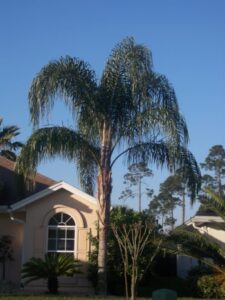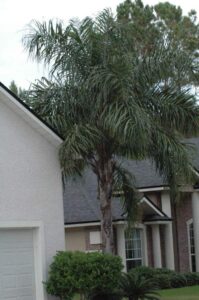Queen Palms
( Syagrus Romanzoffiana )

Queen Palm / Syagrus romanzoffiana Origins:
-Queen Palm / Syagrus romanzoffiana is native to South America and makes
an excellent ornamental palm specimen for the warmer forst free areas of our North Florida /
Jacksonville / St. Augustine area commercial and residential landscapes. ( Plant may sufer frond damage in
more frost prone areas of Northern Florida but will acclimate itself into its new home and become hardier
through the years.)
Queen Palm / Syagrus romanzoffiana Preferred Exposure:
– Full sun is preferable in the North Florida landscape but Queen Palm / Syagrus romanzoffiana will also tolerate a partial shade and partial sun location without difficulty.
Queen Palm / Syagrus romanzoffiana Fronds | Trunk:
– Foliage of the Queen Palm remains evergreen through the winter in the North Florida landscape.( Plant may suffer frond damage in more frost prone areas of Northern Florida but will acclimate itself into its new home and become hardier through the years.)
– One of the most widely cultivated Palms of South America and for good reason the graceful arching feather like fronds make a dramatic landscape statement and are a deep green glossy color. Fronds may reach 10 ft+ in length.
– Queen Palms have somewhat slender ( only about a foot across)
single trunks, although they are sometimes seen planted in groups with double or even triple trunks, wood is gray and retains circular scars from old leaf fronds that ring the trunks horizontally and add to the palms overall appeal.
– Old leaf fronds are resistant to wind damage and remain on the trunks for prolonged periods of time requiring you to prune them off as needed to keep the palm looking its best.
Queen Palm Soil Preference / Salt tolerance:
– Queen Palm planted in the North Florida | Jacksonville | St. Augustine
landscape will tolerate virtually any soil components, but will do best when planted into slightly acidic not alkaline soils.
– Only moderately salt tolerant.
– Queen Palms will tolerate short periods of water drenched soil and well draining sites, continually wet soils should be avoided as root rot can become an issue.
Queen Palm Size Variance:
– Queen Palm are very fast growing they can reach sizes
of 25-50 feet H | and spreading 15-25 feet in width. Often seen on the smaller end of the size scale in the North Florida landscape.
Queen Palm Growth Habit:
– Queen Palm has broad spreading highly decorative foliage and fronds form a broad full crown with gracefully arching foliage that tends to weep downwards.
Queen Palm Growth Rate:
– Very fast growing palm tree selection will quickly establish itself into the North Florida landscape.
– Depending on growing conditions, fertilizer and water applications etc.
healthy palms may put on1-3 feet of growth each year.
Queen Palm Bloom:
– White to yellow flower clusters are quite showy in large draping clusters
hanging down between branches.
Queen Palm Water Requirements:
– Modrately drought tolerant once established into the landscape. Take care to water your queen palm well for the first few months after being planted from and S & J Nursery container into the landscape.
– Fast growing Queen Palms respond well to supplemental irrigation and
fertilizer treatments.
Best Uses For Queen Palms / Syagrus Romanzoffiana in the North Florida |
Jacksonville | St. Augustine area landscape:
– Queen Palms are an excellent choice for a landscape statement
for smaller frontage more modern yards and gardens or commercial buildings where their highly decorative heads can be fully appreciated as a focal accent of the landscape.
– Soft root systems allow palms to be planted near house foundations,
patios, walkways and other hardscape with no damage to the tree or the paved areas.
Care of Queen Palm:
– Queen Palm will need good water during the establishment period and are drought tolerant once established into the landscape.
– Fast growing Queen Palms respond well to supplemental irrigation and
fertilizer treatments.
– Fertilize each fall generously with magnesium sulfate and palm food to ensure your palm goes into the winter season as healthy as possible.
MINIMUM PALM FERTILIZER REGIMEN – what you should be doing to keep your palm
healthy
– Fertilize each spring with a specially blended fertilizer for Palms, follow
manufacturers directions and apply 1/2 lb o 1lb of fertilizer per inch of diameter of trunk on your palm, measured from a hands width above the ground level. That means for a 12 inch wide trunk from left to right you
would need 6-12 lbs of fertilizer for just that one palm!
– Fertilize every fall with magnesium sulfate ( Epsom Salt) to keep your palm green and healthy through the winter months!
MAXIMUM PALM FERTILIZER REGIMEN – what you can do to get your palm up and growing
Fast!
– Fertilize every three months with your choice of Palm fertilizer and
Magnesium Sulfate. Water 3-4 times per week and make sure to water thoroughly after each fertilizer application.
– Wait till fronds have turned completely brown before removing from the palm as the palm will take back in the nutrients from those older leaves ad use it when forming new ones.
*CAUTION – DO NOT FERTILIZE NEWLY PLANTED
/ TRANSPLANTED
FIELD GROWN PALM TREES WITH PALM
FOOD!
Note : When planting smaller palms being grown in a container, this rule does not apply, rather, use half the recommended application rate for your trunks diameter, as container palms roots have not been damaged or cut during planting but are still only a portion as large as they would be if the palm had been growing in the ground and excess fertilizer on a confined root system is still not preferable for maximum health.
Palm fertilizers are water soluble and will burn the new roots your palm tree is trying to put out as it establishes itself into the landscape. It is best to use only poly coated plant food that is heat release like Osmocote general purpose fertilizer or non burning Milorganite in the first year in the landcape, and then the following year, start your palm food regimen that will provide all of the minor nutrients that your palms will need to keep them healthy and problem free in Florida’s soils.

